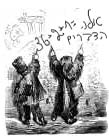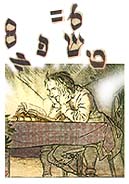Articulation
(mivta), writing (mihtav), and thought (mahshav)
form three superimposed layers of meditation in Jewish mysticism.
Letters are the elements of every one of them, elements which manifest
themselves in ever more spiritual forms. From the motion of the
letters of thought result the truths of reason. From the motion
of the letters of thought result the truths of reason. But the
mystic
will not stop here. He differentiates between matter and form of
the letters in order to approach closer to their spiritual nucleus;
he immerses himself in the combinations of the pure forms of the
letters, which now, being purely spiritual forms, impress themselves
upon his soul. He endeavors to comprehend the connections between
words and names formed by the Kabbalistic methods of exegesis.
The
numerical value of words, gematria, is here of particular
importance.
(Gershom
Scholem, Major Trends in Jewish Mysticism) |
According
to the mystical view, the entire Torah is made up of holy names which
have been so skillfully secreted among the letters of the text that
only an expert can ferret them out. Various systems were applied to
facilitate the allegorical and mystical interpretation of the Bible,
and to uncover secrets and allusions. These methods included displacing
the letters with other letters, abbreviations, substitutions, permutations.
Among the most popular methods was gematria, the process of creating
equivalences from the numerical values of individual words and of entire
sentences.
 Because
the letters of the Hebrew alphabet also serve as numerals [aleph=1,
bet=2, gimel=3, etc.], they provided an ingenious method
of reading novel and unexpected meanings into a text. Writes Joshua
Trachtenberg in Jewish Magic and Superstition: "This method
was very popular and was elaborated in the course of time until it became
an exercise in higher mathematics, which no doubt possessed intrinsic
interest for its devotees in addition to its practical utility in interpreting
the Bible, and in creating new [magical] names."
Because
the letters of the Hebrew alphabet also serve as numerals [aleph=1,
bet=2, gimel=3, etc.], they provided an ingenious method
of reading novel and unexpected meanings into a text. Writes Joshua
Trachtenberg in Jewish Magic and Superstition: "This method
was very popular and was elaborated in the course of time until it became
an exercise in higher mathematics, which no doubt possessed intrinsic
interest for its devotees in addition to its practical utility in interpreting
the Bible, and in creating new [magical] names."
The
use of letters to signify numbers was known to the Babylonians and the
Greeks. In rabbinic literature gematria first appears in statements
by the sages of the second century (tannaim). R. Nathan states
that the phrase  (Elleh
ha-devarim; these are the words) occurring in Exodus 35:1 hint at
the 39 categories of work forbidden on the Sabbath. How? The plural
(Elleh
ha-devarim; these are the words) occurring in Exodus 35:1 hint at
the 39 categories of work forbidden on the Sabbath. How? The plural (devarim)
indicates 2, the additional article
(devarim)
indicates 2, the additional article  ("ha":
a third), while the numerical equivalent of elleh is 36. 36+2+1=39.[1]
("ha":
a third), while the numerical equivalent of elleh is 36. 36+2+1=39.[1]
Gematria
has little significance in Jewish religious law (halakhah); where
it does occur it is used only as a hint or a mnemonic. For example,
the rabbis derive the time period for which a man is to take a nazirite
vow (a period not specified in the Bible) from the numerical value of
the word  ("yihyeh"; he shall be"): Numbers 6:5 – 30.
In this case, as in many others, the regulation or thought preceded
the rabbis' numerical calculation; i.e., the gematria did not invent
the regulation, custom or thought but was developed to support or promote
one that already current or in effect.
("yihyeh"; he shall be"): Numbers 6:5 – 30.
In this case, as in many others, the regulation or thought preceded
the rabbis' numerical calculation; i.e., the gematria did not invent
the regulation, custom or thought but was developed to support or promote
one that already current or in effect.
 The
medieval collections of midrashim are rich with gematriot,
used to facilitate the interpretation of the Biblical text. The use
of gematriot was especially developed among the German Hasidim
(Hasidei Ashkenaz)[2]
in the 12th and 13th centuries. These mystics "were in the habit
of counting or calculating every word in the prayers, benedictions and
hymns, and they sought a reason in the Torah for the number of words
in the prayers."[3]
They elaborated mystical traditions regarding Holy Names of God and
of the angels, although they frequently drew upon earlier mystical traditions.
The
medieval collections of midrashim are rich with gematriot,
used to facilitate the interpretation of the Biblical text. The use
of gematriot was especially developed among the German Hasidim
(Hasidei Ashkenaz)[2]
in the 12th and 13th centuries. These mystics "were in the habit
of counting or calculating every word in the prayers, benedictions and
hymns, and they sought a reason in the Torah for the number of words
in the prayers."[3]
They elaborated mystical traditions regarding Holy Names of God and
of the angels, although they frequently drew upon earlier mystical traditions.
Two
famous commentaries, Pa'ne'ah Raza (Isaac b. Judah ha-Levi, late
13th c.) and Ba'al ha-Turim (Jacob b. Asher, c.1270-1340) are
filled with these numerical word plays. The noted writer of esoteric
theology and ethics Elazar of Worms (c.1165-1230) makes extensive use
of gematriot (sometimes based on entire sentences) to find hints
and supports for existing laws and customs; he establishes, for example,
from the numerical value of the verse in Exodus 23:15, that work that
can be deferred until after the festival should not be performed on
the intermediary days (hol ha-moed) of a festival. He also uses
numerical calculations to connect the midrashic legends with words of
the biblical verses, and to reveal the hidden secrets of Merkaba[4]
mysticism and of angels. For example, he determines that the numerical
value of the sum of the letters in the verse "I have gone down
into the nut garden" (Song of songs 6:11) is equivalent in numerical
value to the mystical verse "This is the depth of the chariot."
The
17th century work Megalleh Amukot (Revealing the Depths)
by Nathan Bata b. Solomon Spira is the classic kabbalistic work[5]
that makes use of gematria as a means of thought and commentary; in
later kabbalistic literature (18th-19th centuries) gematria appears
in many major works as well. The followers of the mystic and false messiah
Shabbetai Zevi (late 17th c.) used numerical calculations to prove the
validity of his messianism. Opponents of the Kabbalah were quick to
voice their criticism of the method. As early as the 13th century, the
great scholar Nahmanides, himself a Kabbalist, recognized the inherent
danger in reading meanings into the text using gematria, and
warned against its exaggerated and arbitrary use: one should not, he
wrote "calculate a gematria in order to deduce from it something
that occurs to him."[6]
The
use of gematria was widespread not only in Eastern Europe but
among the Sephardim as well (particularly among North African rabbis).
It is used to this day to discover the deeper meanings of the biblical
text.
Other
rabbinic examples of gematria:
1. (redu; "go down" — Gen. 42:12)
referring to going down to Egypt. The numerical value of
(redu; "go down" — Gen. 42:12)
referring to going down to Egypt. The numerical value of  (resh, daled, vav) is 210, the number of years of Egyptian bondage.
This reading of the text thus foretells the future.
(resh, daled, vav) is 210, the number of years of Egyptian bondage.
This reading of the text thus foretells the future.
2.
The 318 men referred to in Genesis 14:14 were in fact not 318, but only
Eliezer the servant of Abraham, the numerical equivalent of  Eliezer's name being 318.
Eliezer's name being 318.
3.
R. Judah inferred from the verse, "From the fowl of the heavens
until the beast are fled and gone" (Jer. 9:9), that for 52 years
no traveler passed through Judea, since the numerical value of  (behemah; beast) is 52.
(behemah; beast) is 52.
4.
The rabbis teach:  "When wine enters [one's body], secrets escape." The numerical
value of both
"When wine enters [one's body], secrets escape." The numerical
value of both  (yayin; wine) and
(yayin; wine) and  (sod; secret) is seventy.
(sod; secret) is seventy.
|
[1]
BT Shabbat 70a [back]
[2] The Pious Ones, a term that refers to the various
circles of Jewish mystics and pietists in Ashkenaz (that is, Germany
(mainly the Rhineland) and northern France
in the second half of the twelfth and thirteenth centuries. The
term refers to several schools, most of them independent of each
other, which developed different theologies and world views; many
of their ideas and symbols were later absorbed by the Kabbalah.
[back]
[3] Jacob ben Asher (c.1270-1340), codifier and
author of the Arba'ah Turim, was born in Germany and immigrated
to Spain with his father. [back]
[4] Mystical, esoteric speculations regarding the
celestial realms, based on the vision of the celestial chariot described
in Ezekiel 1. [back]
[5] esoteric, theosophical teachings that appeared
in the twelfth and thirteenth centuries in Provence and northern
Spain soon came to be designated as Kabbalah.[back]
[6] Sefer ha-Geulah. [back] |
LETTERS
Table of Contents

